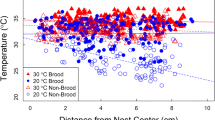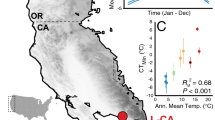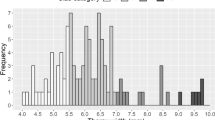Abstract
The time required to recover from cold exposure (chill coma recovery time) may represent an important metric of performance and has been linked to geographic distributions of diverse species. Chill coma recovery time (CCRT) has rarely been measured in bumble bees (genus Bombus) but may provide insights regarding recent changes in their distributions. We measured CCRT of Bombus vosnesenskii workers reared in common garden laboratory conditions from queens collected across altitude and latitude in the Western United States. We also compared CCRTs of male and female bumble bees because males are often overlooked in studies of bumble bee ecology and physiology and may differ in their ability to respond to cold temperatures. We found no relationship between CCRT and local climate at the queen collection sites, but CCRT varied significantly with sex and body mass. Because differences in the ability to recover from cold temperatures have been shown in wild-caught Bombus, we predict that variability in CCRT may be strongly influenced by plasticity.



Similar content being viewed by others
References
Andersen MK, Overgaard J (2019) The central nervous system and muscular system play different roles for chill coma onset and recovery in insects. Comp Biochem Physiol A Mol Integr Physiol 233:10–16. https://doi.org/10.1016/j.cbpa.2019.03.015
Andersen MK, Overgaard J (2020) Maintenance of hindgut reabsorption during cold exposure is a key adaptation for Drosophila cold tolerance. J Exp Biol. https://doi.org/10.1242/jeb.213934
Andersen JL, Manenti T, Sørensen JG, MacMillan HA, Loeschcke V, Overgaard J (2015) How to assess Drosophila cold tolerance: chill coma temperature and lower lethal temperature are the best predictors of cold distribution limits. Funct Ecol 29:55–65. https://doi.org/10.1111/1365-2435.12310
Andersen MK, Folkersen R, MacMillan HA, Overgaard J (2017a) Cold acclimation improves chill tolerance in the migratory locust through preservation of ion balance and membrane potential. J Exp Biol 220:487–496. https://doi.org/10.1242/jeb.150813
Andersen MK, MacMillan HA, Donini A, Overgaard J (2017b) Cold tolerance of Drosophila species is tightly linked to the epithelial K+ transport capacity of the Malpighian tubules and rectal pads. J Exp Biol 220:4261–4269. https://doi.org/10.1242/jeb.168518
Anderson AR, Hoffmann AA, McKechnie SW (2005) Response to selection for rapid chill-coma recovery in Drosophila melanogaster: physiology and life-history traits. Genet Res 85:15–22. https://doi.org/10.1017/S0016672304007281
Angert AL, Sheth SN, Paul JR (2011) Incorporating population-level variation in thermal performance into predictions of geographic range shifts. Integr Comp Biol 51:733–750. https://doi.org/10.1093/icb/icr048
Ayrinhac A, Debat V, Gibert P, Kister A-G, Legout H, Moreteau B, Vergilino R, David JR (2004) Cold adaptation in geographical populations of Drosophila melanogaster: phenotypic plasticity is more important than genetic variability. Funct Ecol 18:700–706
Baudier KM, Mudd AE, Erickson SC, O’Donnell S (2015) Microhabitat and body size effects on heat tolerance: implications for responses to climate change (army ants: Formicidae, Ecitoninae). J Anim Ecol 84:1322–1330. https://doi.org/10.1111/1365-2656.12388
Bayley JS, Winther CB, Andersen MK, Grønkjær C, Nielsen OB, Pedersen TH, Overgaard J (2018) Cold exposure causes cell death by depolarization-mediated Ca2+ overload in a chill-susceptible insect. Proc Natl Acad Sci USA 115:E9737–E9744. https://doi.org/10.1073/pnas.1813532115
Boersma N, Boardman L, Gilbert M, Terblanche JS (2018) Sex-dependent thermal history influences cold tolerance, longevity and fecundity in false codling moth Thaumatotibia leucotreta (Lepidoptera: Tortricidae). Agric for Entomol 20:41–50. https://doi.org/10.1111/afe.12227
Braschler B, Duffy GA, Nortje E et al (2020) Realised rather than fundamental thermal niches predict site occupancy: implications for climate change forecasting. J Anim Ecol 89:2863–2875. https://doi.org/10.1111/1365-2656.13358
Carrington J, Andersen MK, Brzezinski K, MacMillan H 2020. Hyperkalemia, not apoptosis, accurately predicts chilling injury in individual locusts. bioRxiv. 2020.07.03.186759. https://doi.org/10.1101/2020.07.03.186759
Castañeda LE, Lardies MA, Bozinovic F (2005) Interpopulational variation in recovery time from chill coma along a geographic gradient: a study in the common woodlouse, Porcellio laevis. J Insect Physiol 51:1346–1351. https://doi.org/10.1016/j.jinsphys.2005.08.005
Coello Alvarado LE, MacMillan HA, Sinclair BJ (2015) Chill-tolerant Gryllus crickets maintain ion balance at low temperatures. J Insect Physiol 77:15–25. https://doi.org/10.1016/j.jinsphys.2015.03.015
David JR, Gibert P, Pla E, Petavy G, Karan D, Moreteau B (1998) Cold stress tolerance in Drosophila: analysis of chill coma recovery in D. melanogaster. J Therm Biol 23:291–299. https://doi.org/10.1016/S0306-4565(98)00020-5
David JR, Gibert P, Moreteau B, Gilchrist GW, Huey RB (2003) The fly that came in from the cold: geographic variation of recovery time from low-temperature exposure in Drosophila subobscura. Funct Ecol 17:425–430
Davidson JK (1990) Nonparallel geographic patterns for tolerance to cold and desiccation in Drosophila melanogaster and Drosophila simulans. Aust J Zool 38:155–161. https://doi.org/10.1071/zo9900155
de la Vega GJ, Medone P, Ceccarelli S, Rabinovich J, Schilman PE (2015) Geographical distribution, climatic variability and thermo-tolerance of Chagas disease vectors. Ecography 38:851–860. https://doi.org/10.1111/ecog.01028
Des Marteaux LE, Sinclair BJ (2016) Ion and water balance in Gryllus crickets during the first twelve hours of cold exposure. J Insect Physiol 89:19–27. https://doi.org/10.1016/j.jinsphys.2016.03.007
Findsen A, Pedersen TH, Petersen AG, Nielsen OB, Overgaard J (2014) Why do insects enter and recover from chill coma? Low temperature and high extracellular potassium compromise muscle function in Locusta migratoria. J Exp Biol 217:1297–1306. https://doi.org/10.1242/jeb.098442
Gerber L, Overgaard J (2018) Cold tolerance is linked to osmoregulatory function of the hindgut in Locusta migratoria. J Exp Biol 221:eb173930. https://doi.org/10.1242/jeb.173930
Gibert P, Huey RB (2001) Chill-coma temperature in Drosophila: effects of developmental temperature, latitude, and phylogeny. Physiol Biochem Zool 74:429–434. https://doi.org/10.1086/320429
Goller F, Esch HE (1990) Muscle potentials and temperature acclimation and acclimatization in flight muscles of workers and drones of Apis mellifera. J Therm Biol 15:307–312
Gonzalez VH, Hranitz JM, Percival CR, Pulley KL, Tapsak ST, Tscheulin T, Petanidou T, Barthell JF (2020) Thermal tolerance varies with dim-light foraging and elevation in large carpenter bees (Hymenoptera: Apidae: Xylocopini). Ecol Entomol 45:688–696. https://doi.org/10.1111/een.12842
Goulson D (2003) Bumblebees: their behaviour and ecology. Oxford University Press, London
Goulson D, Lye GC, Darvill B (2008) Decline and conservation of bumblebees. Annu Rev Entomol 53:191–208
Guo F, Guénard B, Economo EP et al (2020) Activity niches outperform thermal physiological limits in predicting global ant distributions. J Biogeogr 47:829–842. https://doi.org/10.1111/jbi.13799
Hamblin AL, Youngsteadt E, López-Uribe MM, Frank SD (2017) Physiological thermal limits predict differential responses of bees to urban heat-island effects. Biol Lett 13:20170125. https://doi.org/10.1098/rsbl.2017.0125
Harrington R, Taylor LR (1990) Migration for survival: fine-scale population redistribution in an aphid, Myzus persicae. J Anim Ecol 59:1177. https://doi.org/10.2307/5039
Hazell SP, Bale JS (2011) Low temperature thresholds: are chill coma and CTmin synonymous? J Insect Physiol 57:1085–1089. https://doi.org/10.1016/j.jinsphys.2011.04.004
Heinrich B (1972) Energetics of temperature regulation and foraging in a bumblebee, Bombus terricola Kirby. J Comp Physiol 77:49–64
Heinrich B (1974) Thermoregulation in bumblebees: I. Brood incubation by Bombus vosnesenskii queens. J Comp Physiol 88:129–140. https://doi.org/10.1007/BF00695404
Heinrich B (1975) Thermoregulation in bumblebees II. Energetics of warm-up and free flight. J Comp Physiol B 96:155–166. https://doi.org/10.1007/BF00706595
Heinrich B (1979) Bumblebee economics. Harvard University Press, Cambridge
Heinrich B (1993) The hot-blooded insects: strategies and mechanisms of thermoregulation. Harvard University Press
Hijmans RJ, Cameron SE, Parra JL, Jones PG, Jarvis A (2005) Very high resolution interpolated climate surfaces for global land areas. Int J Climatol 25:1965–1978. https://doi.org/10.1002/joc.1276
Hoffmann AA, Hallas R, Sinclair C, Mitrovski P (2001) Levels of variation in stress resistance in Drosophila among strains, local populations, and geographic regions: patterns for desiccation, starvation, cold resistance, and associated traits. Evolution 55:1621–1630. https://doi.org/10.1111/j.0014-3820.2001.tb00681.x
Hoffmann AA, Anderson A, Hallas R (2002) Opposing clines for high and low temperature resistance in Drosophila melanogaster. Ecol Lett 5:614–618. https://doi.org/10.1046/j.1461-0248.2002.00367.x
Hoffmann AA, Sørensen JG, Loeschcke V (2003) Adaptation of Drosophila to temperature extremes: bringing together quantitative and molecular approaches. J Therm Biol 28:175–216. https://doi.org/10.1016/S0306-4565(02)00057-8
Hughes GE, Owen E, Sterk G, Bale JS (2010) Thermal activity thresholds of the parasitic wasp Lysiphlebus testaceipes and its aphid prey: implications for the efficacy of biological control. Physiol Entomol 35:373–378. https://doi.org/10.1111/j.1365-3032.2010.00754.x
Jackson JM, Pimsler ML, Oyen KJ, Koch-Uhuad JB, Herndon JD, Strange JP, Dillon ME, Lozier JD (2018) Distance, elevation and environment as drivers of diversity and divergence in bumblebees across latitude and altitude. Mol Ecol 27:2926–2942. https://doi.org/10.1111/mec.14735
Jackson JM, Pimsler ML, Oyen KJ, Strange JP, Dillon ME, Lozier JD (2020) Local adaptation across a complex bioclimatic landscape in two montane bumblebee species. Mol Ecol 29:920–939. https://doi.org/10.1111/mec.15376
Kerr JT, Pindar A, Galpern P, Packer L, Potts SG, Roberts SM, Rasmont P, Schweiger O, Colla SR, Richardson LL, Wagner DL, Gall LF, Sikes DS, Pantoja A (2015) Climate change impacts on bumblebees converge across continents. Science 349:177–180. https://doi.org/10.1126/science.aaa7031
Koštál V, Vambera J, Bastl J (2004) On the nature of pre-freeze mortality in insects: water balance, ion homeostasis and energy charge in the adults of Pyrrhocoris apterus. J Exp Biol 207:1509–1521. https://doi.org/10.1242/jeb.00923
Lancaster LT, Dudaniec RY, Hansson B, Svensson EI (2015) Latitudinal shift in thermal niche breadth results from thermal release during a climate-mediated range expansion. J Biogeogr 42:1953–1963. https://doi.org/10.1111/jbi.12553
Larsson FK (1989) Insect mating patterns explained by microclimatic variables. J Therm Biol 14:155–157. https://doi.org/10.1016/0306-4565(89)90038-7
Leiva FP, Calosi P, Verberk WCEP (2019) Scaling of thermal tolerance with body mass and genome size in ectotherms: a comparison between water- and air-breathers. Philos Trans R Soc B Biol Sci 374:20190035. https://doi.org/10.1098/rstb.2019.0035
Macdonald SS, Rako L, Batterham P, Hoffmann AA (2004) Dissecting chill coma recovery as a measure of cold resistance: evidence for a biphasic response in Drosophila melanogaster. J Insect Physiol 50:695–700. https://doi.org/10.1016/j.jinsphys.2004.05.004
MacMillan HA, Sinclair BJ (2011) Mechanisms underlying insect chill-coma. J Insect Physiol 57:12–20
MacMillan HA, Williams CM, Staples JF, Sinclair BJ (2012) Reestablishment of ion homeostasis during chill-coma recovery in the cricket Gryllus pennsylvanicus. PNAS 109:20750–20755. https://doi.org/10.1073/pnas.1212788109
MacMillan HA, Findsen A, Pedersen TH, Overgaard J (2014) Cold-induced depolarization of insect muscle: differing roles of extracellular K+ during acute and chronic chilling. J Exp Biol 217:2930–2938. https://doi.org/10.1242/jeb.107516
MacMillan HA, Andersen JL, Davies SA, Overgaard J (2015) The capacity to maintain ion and water homeostasis underlies interspecific variation in Drosophila cold tolerance. Sci Rep. https://doi.org/10.1038/srep18607
Martinet B, Lecocq T, Smet J, Rasmont P (2015) A protocol to assess insect resistance to heat waves, applied to bumblebees (Bombus Latreille, 1802). PLoS ONE 10:e0118591. https://doi.org/10.1371/journal.pone.0118591
Mellanby K (1939) Low temperature and insect activity. Proc R Soc Lond Ser B Biol Sci 127:473–487. https://doi.org/10.1098/rspb.1939.0035
Modlmeier AP, Pamminger T, Foitzik S, Scharf I (2012) Cold resistance depends on acclimation and behavioral caste in a temperate ant. Naturwissenschaften 99:811–819. https://doi.org/10.1007/s00114-012-0963-8
Overgaard J, MacMillan HA (2017) The integrative physiology of insect chill tolerance. Annu Rev Physiol. https://doi.org/10.1146/annurev-physiol-022516-034142
Owen EL, Bale JS, Hayward SAL (2013) Can winter-active bumblebees survive the cold? Assessing the cold tolerance of Bombus terrestris audax and the effects of pollen feeding. PLoS ONE 8:e80061. https://doi.org/10.1371/journal.pone.0080061
Oyen KJ, Dillon ME (2018) Critical thermal limits of bumblebees (Bombus impatiens) are marked by stereotypical behaviors and are unchanged by acclimation, age or feeding status. J Exp Biol 221:jeb165589. https://doi.org/10.1242/jeb.165589
Oyen KJ, Giri S, Dillon ME (2016) Altitudinal variation in bumblebee (Bombus) critical thermal limits. J Therm Biol 59:52–57. https://doi.org/10.1016/j.jtherbio.2016.04.015
Pimsler ML, Oyen KJ, Herndon JD, Jackson JM, Strange JP, Dillon ME, Lozier JD (2020) Biogeographic parallels in thermal tolerance and gene expression variation under temperature stress in a widespread bumblebee. Sci Rep 10:17063. https://doi.org/10.1038/s41598-020-73391-8
Pinheiro J, Bates D, DebRoy S, Sarkar D, R Core Team (2013) nlme: Linear and nonlinear mixed effects models. https://CRAN.R-project.org/package=nlme
Polilov AA, Makarova AA (2017) The scaling and allometry of organ size associated with miniaturization in insects: a case study for Coleoptera and Hymenoptera. Sci Rep 7:43095. https://doi.org/10.1038/srep43095
R Development Core Team (2017) R: a language and environment for statistical computing. R Foundation for Statistical Computing, Vienna
Revelle W (1979) Hierarchical cluster analysis and the internal structure of tests. Multivar Behav Res 14:57–74. https://doi.org/10.1207/s15327906mbr1401_4
Revelle W (2020) psych: Procedures for psychological, psychometric, and personality research. Northwestern University, Evanston
Robertson RM, Spong KE, Srithiphaphirom P (2017) Chill coma in the locust, Locusta migratoria, is initiated by spreading depolarization in the central nervous system. Sci Rep 7:10297. https://doi.org/10.1038/s41598-017-10586-6
Sinclair BJ, Williams CM, Terblanche JS (2012) Variation in thermal performance among insect populations. Physiol Biochem Zool 85:594–606. https://doi.org/10.1086/665388
Sinclair BJ, Coello Alvarado LE, Ferguson LV (2015) An invitation to measure insect cold tolerance: methods, approaches, and workflow. J Therm Biol 53:180–197. https://doi.org/10.1016/j.jtherbio.2015.11.003
Sisodia S, Singh BN (2010) Influence of developmental temperature on cold shock and chill coma recovery in Drosophila ananassae: acclimation and latitudinal variations among Indian populations. J Therm Biol 35:117–124. https://doi.org/10.1016/j.jtherbio.2010.01.001
Soroye P, Newbold T, Kerr J (2020) Climate change contributes to widespread declines among bumblebees across continents. Science 367:685–688. https://doi.org/10.1126/science.aax8591
Stelzer RJ, Chittka L (2010) Bumblebee foraging rhythms under the midnight sun measured with radiofrequency identification. BMC Biol 8:93. https://doi.org/10.1186/1741-7007-8-93
Stoks R, Block MD (2011) Rapid growth reduces cold resistance: evidence from latitudinal variation in growth rate, cold resistance and stress proteins. PLoS ONE 6:e16935. https://doi.org/10.1371/journal.pone.0016935
Strange JP (2010) Nest initiation in three North American bumblebees (Bombus): Gyne number and presence of honey bee workers influence establishment success and colony size. J Insect Sci 10:130. https://doi.org/10.1673/031.010.13001
Sunday JM, Bates AE, Dulvy NK (2012) Thermal tolerance and the global redistribution of animals. Nat Clim Change 2:686–690. https://doi.org/10.1038/nclimate1539
Terblanche JS, Klok CJ, Krafsur ES, Chown SL (2006) Phenotypic plasticity and geographic variation in thermal tolerance and water loss of the tsetse Glossina pallidipes (Diptera: Glossinidae): implications for distribution modelling. Am J Trop Med Hyg 74:786–794. https://doi.org/10.4269/ajtmh.2006.74.786
Tonione MA, Cho SM, Richmond G, Irian C, Tsutsui ND (2020) Intraspecific variation in thermal acclimation and tolerance between populations of the winter ant, Prenolepis imparis. Ecol Evol 10:4749–4761. https://doi.org/10.1002/ece3.6229
Warren DL, Seifert SN (2011) Ecological niche modeling in Maxent: the importance of model complexity and the performance of model selection criteria. Ecol Appl 21:335–342. https://doi.org/10.1890/10-1171.1
Weidenmüller A, Kleineidam C, Tautz J (2002) Collective control of nest climate parameters in bumblebee colonies. Anim Behav 63:1065–1071. https://doi.org/10.1006/anbe.2002.3020
Whitford WG, Ettershank G (1975) Factors affecting foraging activity in Chihuahuan desert harvester ants. Environ Entomol 4:689–696. https://doi.org/10.1093/ee/4.5.689
Williams PH, Thorp RW, Richardson LL, Colla SR (2014) Bumblebees of North America: an identification guide. Princeton University Press
Woodard SH (2017) Bumblebee ecophysiology: integrating the changing environment and the organism. Curr Opin Insect Sci 22:101–108. https://doi.org/10.1016/j.cois.2017.06.001
Zeilstra I, Fischer K (2005) Cold tolerance in relation to developmental and adult temperature in a butterfly. Physiol Entomol 30:92–95. https://doi.org/10.1111/j.0307-6962.2005.00430.x
Acknowledgements
We thank L. Rachocki and N. Wojcieszak for help with colony rearing and maintenance.
Funding
This material is based upon work supported by the National Science Foundation under Grant Nos. DEB-1457659 to MED and JPS and DEB-1457645 to JDL. MED was additionally supported by Grant Nos. OIS-1826834 and EF-1921562 during the completion of the manuscript. Any opinions, findings, and conclusions or recommendations expressed in this material are those of the author(s) and do not necessarily reflect the views of the National Science Foundation.
Author information
Authors and Affiliations
Contributions
MED, JPS, and JDL originally formulated the idea. KJO, LEJ, ZMP, and MED developed the methodology. JDH and JPS raised colonies from field-collected queens. KJO, LEJ and ZMP collected the data. KJO and MED analyzed the data and led the writing of the manuscript. All authors contributed critically to the drafts and gave final approval for publication.
Corresponding author
Ethics declarations
Conflict of interest
The authors declare that they have no conflict of interest.
Additional information
Communicated by K.H. Dausmann.
Publisher's Note
Springer Nature remains neutral with regard to jurisdictional claims in published maps and institutional affiliations.
Supplementary Information
Below is the link to the electronic supplementary material.
360_2021_1385_MOESM1_ESM.png
Supplementary file1 Results of a cluster analysis on monthly minimum temperatures from climate data (worldclim) at queen collection sites across the western US (Fig. 1). The analysis reveals two main clusters (C2 and C10) within which monthly minimums were highly correlated as revealed by uniformly high α (highest correlations between variables) and β (lowest correlations among variables) (Revelle, 1979; 2020). January and July minimum temperatures were thus used in models assessing effects of climate on CCRT (Table 4). See text for details. (PNG 816 KB)
360_2021_1385_MOESM2_ESM.png
Supplementary file2 Results of a cluster analysis on bioclimatic variables (worldclim) for queen collection sites across the western US (Fig. 1). Based on the four clusters, BIO 4 (temperature seasonality), BIO 12 (annual precipitation), BIO 5 (maximum temperature of the warmest month), and BIO 1 (annual mean temperature) were chosen for inclusion in models relating climate to CCRT (Table 4). See (PNG 913 KB)
Rights and permissions
About this article
Cite this article
Oyen, K.J., Jardine, L.E., Parsons, Z.M. et al. Body mass and sex, not local climate, drive differences in chill coma recovery times in common garden reared bumble bees. J Comp Physiol B 191, 843–854 (2021). https://doi.org/10.1007/s00360-021-01385-7
Received:
Revised:
Accepted:
Published:
Issue Date:
DOI: https://doi.org/10.1007/s00360-021-01385-7




